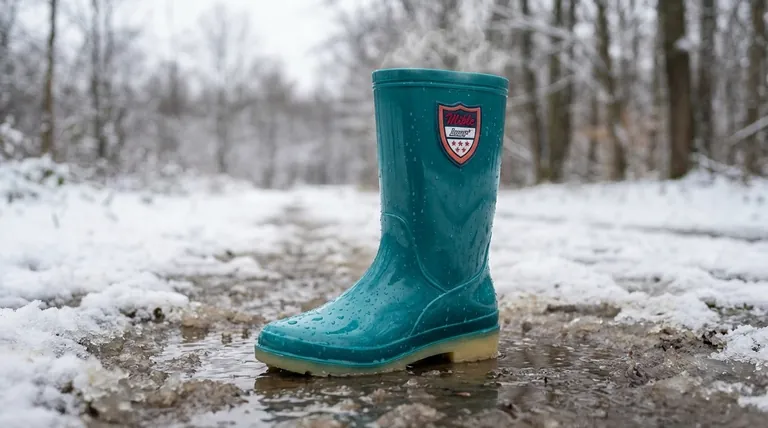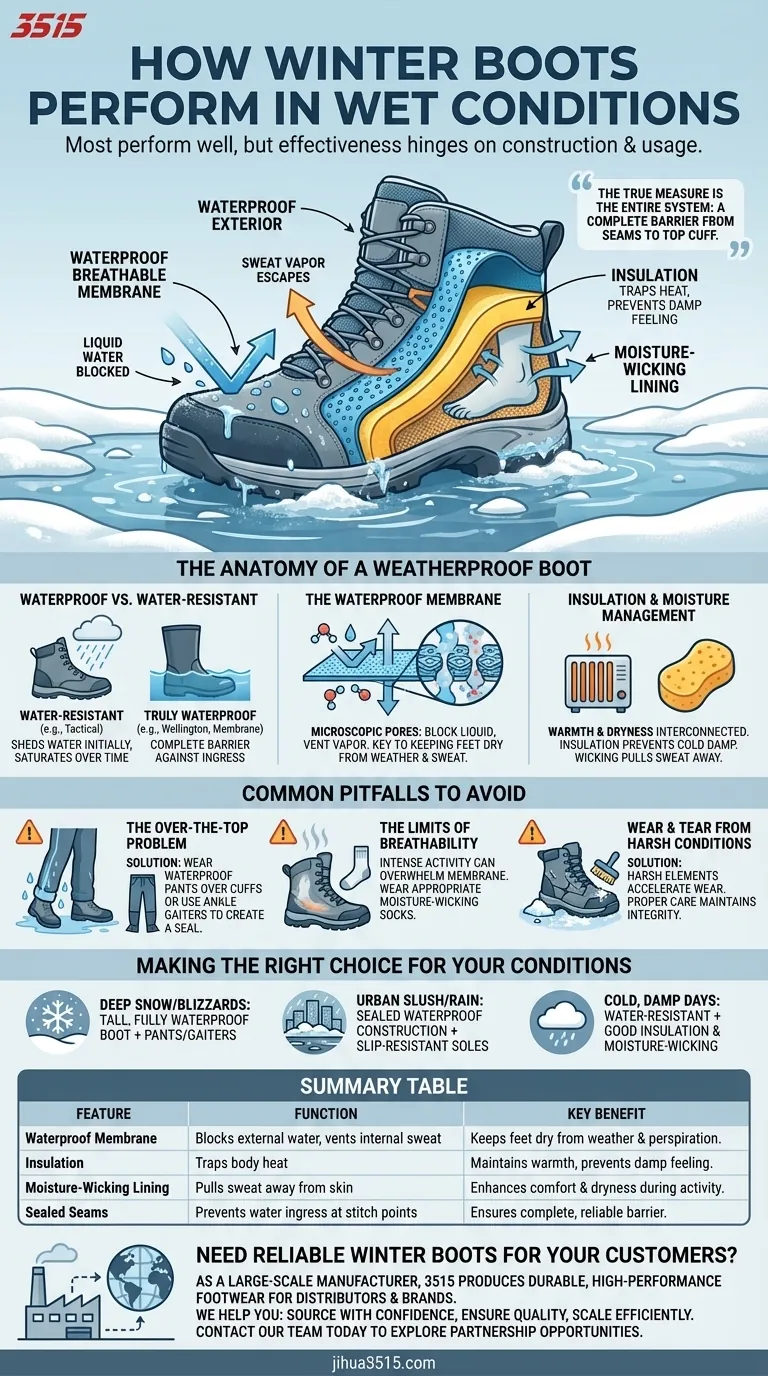In short, most winter boots are designed to perform exceptionally well in wet conditions, but their effectiveness hinges on their specific construction and how they are worn. They use waterproof materials, insulation, and moisture-wicking properties to keep your feet dry from both external elements and internal sweat.
The true measure of a winter boot's performance in wet conditions is not just its material, but its entire system. A truly effective boot creates a complete barrier, from sealed seams and waterproof membranes to preventing water from entering over the top cuff.

The Anatomy of a Weatherproof Boot
To understand how winter boots handle wetness, you need to look beyond the surface and consider the technologies designed to keep you dry. Performance is a result of several integrated features working together.
Waterproof vs. Water-Resistant
The most crucial distinction is between waterproof and water-resistant. Water-resistant materials, often found on packer or tactical boots, will shed water initially but can become saturated with prolonged exposure.
Truly waterproof boots, like wellingtons or those with a specialized membrane, are designed to provide a complete barrier against water ingress, keeping you dry in deep snow, slush, and rain.
The Role of the Waterproof Membrane
Many high-performance police and military boots incorporate a waterproof, breathable membrane. This is a specialized layer built into the boot's construction.
This membrane contains microscopic pores that are too small for liquid water molecules to pass through from the outside, but large enough for smaller water vapor molecules (sweat) to escape from the inside. This technology is key to keeping feet dry from both weather and perspiration.
Insulation and Moisture Management
Warmth and dryness are interconnected. Insulation not only keeps your feet warm in cold climates but also helps prevent the damp feeling that comes from cold feet.
Furthermore, many boots feature moisture-wicking linings. These materials pull sweat away from your skin to the boot's interior surface, where it can evaporate through the breathable membrane, preventing discomfort.
Common Pitfalls to Avoid
Even the best boots can fail if their limitations aren't understood. The most common issues are not with the boot itself, but with how it integrates with the rest of your gear.
The Over-the-Top Problem
The most common point of failure for a waterproof boot is water entering from the top cuff. Deep snow, heavy rain, or significant splashing can allow moisture to run down your leg and into the boot.
This can be easily prevented by wearing waterproof pants over the boot cuffs or by using accessories like ankle gaiters to create a seal.
The Limits of Breathability
While breathable membranes are highly effective, they can be overwhelmed in certain conditions. During intense activity, you may produce sweat faster than the membrane can vent it, leading to a damp feeling inside the boot.
This doesn't mean the boot is leaking from the outside. It highlights the importance of wearing appropriate moisture-wicking socks to help manage internal moisture.
Wear and Tear from Harsh Conditions
Harsh winter elements like deep snow, slush, and road salt can accelerate the wear and tear on any footwear. Waterproof boots are inherently more durable in these conditions, but they still require proper care to maintain their integrity over time.
Making the Right Choice for Your Conditions
Choosing the right boot depends entirely on the environment you'll be facing.
- If your primary focus is deep snow or blizzards: Prioritize a tall, fully waterproof boot and ensure you have waterproof pants or gaiters to prevent snow from getting in over the top.
- If your primary focus is urban slush and rain: Look for boots with a sealed, waterproof construction and excellent slip-resistant soles to handle icy, wet pavement.
- If your primary focus is cold, damp days with minimal precipitation: A water-resistant boot with good insulation and moisture-wicking properties will provide excellent comfort and protection.
Ultimately, selecting the right winter boot is about matching its specific weather-handling features to your intended use.
Summary Table:
| Feature | Function | Key Benefit |
|---|---|---|
| Waterproof Membrane | Blocks external water, vents internal sweat | Keeps feet dry from weather and perspiration |
| Insulation | Traps body heat | Maintains warmth, which helps prevent a damp feeling |
| Moisture-Wicking Lining | Pulls sweat away from skin | Enhances comfort and dryness during activity |
| Sealed Seams | Prevents water ingress at stitch points | Ensures a complete, reliable waterproof barrier |
Need Reliable Winter Boots for Your Customers?
As a large-scale manufacturer, 3515 produces a comprehensive range of durable, high-performance footwear for distributors, brand owners, and bulk clients. Our production capabilities encompass all types of waterproof and insulated boots designed to excel in harsh, wet conditions.
We help you:
- Source with Confidence: Access a wide catalog of proven winter boot designs.
- Ensure Quality: Benefit from our expertise in waterproof construction and durable materials.
- Scale Efficiently: Meet large-volume orders with consistent quality and reliable delivery.
Let's discuss your specific needs. Contact our team today to explore partnership opportunities.
Visual Guide

Related Products
- Factory Direct Wholesale Rain Boots Durable Waterproof & Fully Customizable
- Premium Wholesale Waterproof Safety Boots High Performance Protection for Industrial Markets
- High Performance Fire-Retardant Waterproof Safety Boots
- Wholesale Safety Footwear Manufacturer for Bulk & Custom OEM Orders
- Customizable Anti-Smash Safety Boots for Wholesale & Private Label Manufacturing
People Also Ask
- What variety of rubber boots is available? From Rain to Safety and Medical Solutions
- What are the drawbacks of rubber boots regarding breathability and comfort? Understanding the Moisture Trap
- What factors should be considered when choosing rain boots? Find the Perfect Boot for Your Needs
- What are the main materials used in the production of rain boots? A Guide to Durability & Comfort
- What are the distinctive features of rain boots? Unmatched Waterproof Protection Explained



















